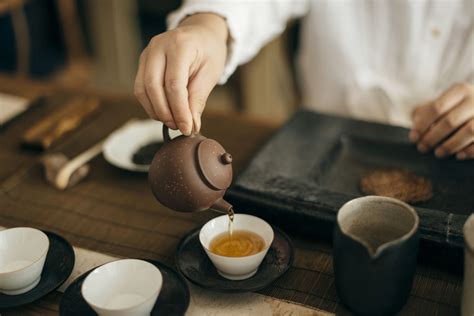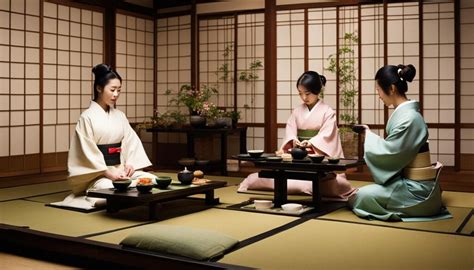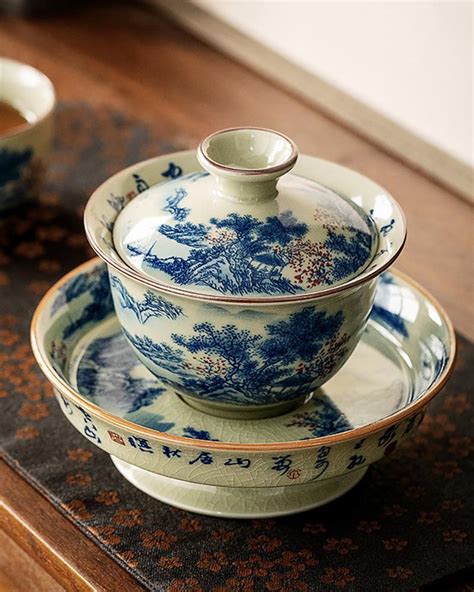Imagine a world where every sip of tea transports you to the enchanting streets of ancient China, revealing the rich heritage of traditional Chinese teaware. Step into a realm where craftsmanship and symbolism intertwine, as delicate teapots and elegant cups become vessels for not just tea, but stories of generations past.
Indulge in the serenity of a tea ceremony, where time slows down and each movement is an art form. Discover the secrets of teaware passed down through the ages, carrying with them the essence of Chinese philosophy and aesthetic. From the vibrant blue and white patterns of porcelain to the earthy warmth of Yixing clay, each piece holds a story waiting to be told.
Marvel at the intricacy of hand-painted designs, where every stroke is a testament to the skill and precision of the artist. Feel the weight of history in your hands as you hold a teacup, knowing that it is not just a vessel, but a symbol of hospitality, friendship, and respect in Chinese culture.
Embark on a journey to explore the wonders of traditional Chinese teaware, as we delve into the significance of teapots, teacups, and tea ceremonies. Uncover the rituals and beliefs intertwined with the act of brewing and serving tea, and gain a deeper understanding of the cultural heritage that continues to inspire tea lovers around the world.
Ancient Origins of Chinese Tea Culture

The rich and vibrant tapestry of Chinese tea culture can be traced back thousands of years, deeply rooted in the ancient traditions and customs of the country. This section explores the historical origins and fascinating evolution of Chinese tea, highlighting its significance in Chinese society.
In ancient times, tea was not just a beverage but an integral part of spiritual, social, and daily life in China. The cultivation and preparation of tea were seen as sacred rituals, embodying harmony, tranquility, and a deep connection with nature. The art of tea drinking was considered a form of meditation, allowing individuals to find inner peace and enlightenment.
The origins of Chinese tea culture can be found in the mythical tales and legends surrounding its discovery. It is believed that tea was first discovered by the legendary emperor Shennong, who was known for his extensive knowledge of medicinal herbs and plants. According to the ancient texts, one fateful day, as the emperor was resting under a tree, a few tea leaves fell into his pot of boiling water, giving birth to the first infusion of tea.
| Throughout history, tea has played a pivotal role in Chinese society, both as a symbol of hospitality and as a way to strengthen social bonds. It was often used as a gift to convey respect and honor, offered to guests during important occasions and gatherings. | Tea houses and tea ceremonies became popular during the Tang dynasty, providing a space for intellectual discussions, poetry recitals, and social interactions. These gatherings were not only an opportunity to taste different varieties of tea but also to appreciate the aesthetic beauty of teaware and the intricate art of tea preparation. |
| The Ming and Qing dynasties witnessed a flourishing tea culture, with elaborate tea sets and utensils being crafted by skilled artisans. The delicate porcelain teapots, teacups, and tea trays became highly valued possessions, showcasing the exquisite craftsmanship of the time. | Furthermore, tea became an important trading commodity, with tea routes connecting China to neighboring countries and beyond. Tea merchants traveled long distances, spreading Chinese tea culture and introducing different tea varieties and brewing techniques to the world. |
| Today, the ancient origins of Chinese tea culture continue to shape and influence the modern tea traditions in China and around the world. The reverence for tea, its health benefits, and its role as a social lubricant are deeply ingrained in Chinese society, making tea an integral part of daily life. | Exploring the ancient origins of Chinese tea culture allows us to appreciate the rich heritage and traditions associated with this beloved beverage. From its humble beginnings to its global significance, Chinese tea culture remains a testament to the enduring power and beauty of tradition. |
The Mastery and Complexity of Traditional Chinese Teaware
The world of traditional Chinese teaware is an extraordinary realm of craftsmanship and grace, where art and function intertwine to create timeless pieces unlike any other. From delicate porcelain to robust clay, each material is painstakingly shaped and decorated by skilled artisans, resulting in teaware that is as visually striking as it is highly functional.
As one delves into the artistry of Chinese teaware, one cannot help but marvel at the intricate details and meticulous techniques employed in its creation. Whether it's the precise brushstrokes of an exquisitely painted teapot or the intricate carvings on a tea tray, every element is carefully crafted to showcase the unparalleled skill and creativity of the artisans.
- The use of vibrant and varying colors adds depth and character to the teaware, with hues that range from soft pastels to bold and vibrant shades.
- Embellishments such as gold leaf accents or delicate overlays further enhance the beauty of the teaware, adding a touch of opulence and luxury.
- The shapes and forms of Chinese teaware are also a testament to the mastery of the artisans. From gracefully curved teacups that fit perfectly in the hand to elegantly shaped teapots that pour with precision, each piece is designed to elevate the tea-drinking experience to new heights.
Not only are these teaware pieces visually captivating, but they also carry with them a rich cultural heritage. With a history that spans thousands of years, Chinese teaware has become deeply intertwined with traditional tea ceremonies and rituals. The act of sipping tea from a finely crafted teacup or pouring tea from a beautifully designed teapot becomes a reverent gesture, an opportunity to connect with centuries of history and tradition.
Whether one is a tea connoisseur or simply an admirer of exquisite craftsmanship, exploring the artistry and intricacy of traditional Chinese teaware is a journey that unveils a world of wonder and appreciation. Each piece tells a story, reflecting the culture and aesthetic values of the past while continuing to inspire and captivate in the present.
The Traditional Tea Ceremony: A Delight for the Senses

Embark on a sensory journey as we delve into the captivating realm of the traditional tea ceremony. At the heart of Chinese culture, this timeless practice mesmerizes with its harmonious blend of aesthetics, rituals, and flavors. Through the artful preparation and presentation of tea, a tapestry of sensory delights unfolds, engaging sight, touch, smell, taste, and even sound. Prepare to be transported to a world where tranquility and mindfulness intertwine, offering a profound experience for all who partake in this ancient tradition.
Health Benefits of Chinese Tea and Teaware
Exploring the health benefits associated with Chinese tea and teaware uncovers a myriad of advantages for both the mind and body. From promoting relaxation and mental clarity to boosting the immune system and aiding digestion, Chinese tea has long been revered for its rejuvenating properties. Additionally, the traditional teaware used to prepare and serve Chinese tea further enhances the drinking experience, preserving the tea's flavor and maximizing its health benefits.
Chinese tea, renowned for its rich history and cultural significance, offers numerous health benefits. Its natural antioxidants and polyphenols help fight free radicals, reducing the risk of chronic diseases and promoting overall well-being. The ritualistic act of tea preparation and consumption, often accompanied by serene surroundings, provides a peaceful respite from the hectic pace of modern life. This moment of tranquility can lower stress levels, improve focus, and enhance mindfulness.
Chinese teaware, consisting of various types of tea pots, cups, and utensils, plays a crucial role in preserving the integrity and health benefits of the tea. The materials used to create teaware, such as clay and porcelain, interact with the tea leaves, enhancing its flavor and releasing beneficial compounds. Furthermore, these materials are often heat-retaining, ensuring that the tea remains at its optimal temperature for consumption.
Not only does the use of Chinese teaware contribute to an enhanced tea-drinking experience, but it also impacts the health benefits derived from the tea. The porous nature of clay teapots, for instance, allows for natural seasoning, which enriches the flavor profile of the tea over time. Porcelain cups, on the other hand, are known for their ability to maintain the purity of the tea's taste, preventing any undesirable flavors from seeping in.
In summary, delving into the health benefits of Chinese tea and teaware reveals a wide array of advantages for individuals seeking a holistic approach to their well-being. From the mental benefits of relaxation and focus to the physical benefits of antioxidant intake and improved digestive health, Chinese tea and teaware offer a harmonious combination for enhancing one's overall health and wellness.
Preserving the Legacy: Incorporating Timeless Chinese Teaware into Modern Lifestyles

In this section, we will explore the significance of integrating traditional Chinese teaware into contemporary living, showcasing the immense cultural heritage and craftsmanship behind these esteemed artifacts. By bridging the gap between past and present, we aim to highlight the profound value of preserving and embracing this unique facet of Chinese culture.
As society continues to evolve and modernize, it is crucial to recognize and appreciate the historical significance of traditional Chinese teaware. These exquisite pieces, crafted with meticulous attention to detail and using centuries-old techniques, not only signify an era of sophisticated tea-drinking customs but also embody the essence of Chinese aesthetics and craftsmanship.
Integrating traditional Chinese teaware into our modern lives allows us to engage with the rich tapestry of Chinese heritage while embracing the tranquility and mindfulness that tea traditions promote. The unique shapes, colors, and textures of teaware add a touch of elegance and authenticity to our tea-drinking experiences, elevating the simple act of brewing and savoring tea into a truly immersive journey.
Moreover, by incorporating traditional Chinese teaware into our daily routines, we can foster a deeper connection with nature and the environment. Many ancient teaware materials, such as Yixing clay or Jian kiln porcelain, are known for their natural and sustainable qualities, making them an ideal choice for eco-conscious tea enthusiasts.
Overall, by preserving and integrating traditional Chinese teaware into our modern lifestyles, we honor the legacy of this treasured cultural practice while enhancing our own tea-drinking rituals. Let us explore the various ways we can embrace the charm and grace of Chinese teaware without losing touch with the timeless tradition that it represents.
FAQ
What is traditional Chinese teaware?
Traditional Chinese teaware refers to a wide range of utensils used for brewing and drinking tea in China. It includes teapots, teacups, tea trays, and tea utensils. These pieces are often crafted with delicate designs and made from materials such as porcelain, ceramic, and clay.
Why is Chinese teaware considered special?
Chinese teaware is considered special because it not only serves a functional purpose but also carries deep cultural and historical significance. The craftsmanship behind these teaware pieces showcases China's rich heritage and traditional methods of tea preparation. Each piece is meticulously crafted to bring out the essence and flavors of different types of tea.
How does traditional Chinese teaware enhance the tea-drinking experience?
Traditional Chinese teaware enhances the tea-drinking experience in several ways. The design and material of teapots and cups help in the even distribution of heat, allowing the tea to brew perfectly and retain its flavor. The aesthetic appeal of the teaware also creates a calming and harmonious atmosphere, promoting relaxation and enjoyment while sipping tea.
What are some popular types of Chinese teaware?
Some popular types of Chinese teaware include Yixing teapots, Jingdezhen porcelain tea sets, and Ru kiln teacups. Yixing teapots, made from purple clay, are highly prized for their ability to retain and enhance the flavors of tea. Jingdezhen porcelain tea sets are renowned for their exquisite craftsmanship and intricate patterns. Ru kiln teacups, with their unique glaze and texture, are considered collector's items.
Are there any specific rituals or techniques associated with using traditional Chinese teaware?
Yes, there are specific rituals and techniques associated with using traditional Chinese teaware. For example, the tea is often rinsed with hot water before the brewing process begins to warm the teapot and tea cups. A certain amount of tea leaves is then added to the teapot, and hot water is poured over them to steep the tea. The tea is then poured into the cups in a circular motion, allowing the flavors to be evenly distributed.
What is traditional Chinese teaware?
Traditional Chinese teaware refers to a variety of vessels and tools used in the preparation and consumption of tea in China. This includes teapots, teacups, tea trays, tea strainers, and tea scoops, among others.
What are the key features of traditional Chinese teaware?
Traditional Chinese teaware often showcases exquisite craftsmanship and elegant designs. It is commonly made of materials such as porcelain, clay, and bamboo. The teapots usually have a small spout, a curved handle, and a lid with a button. Teacups are typically small and handleless.



